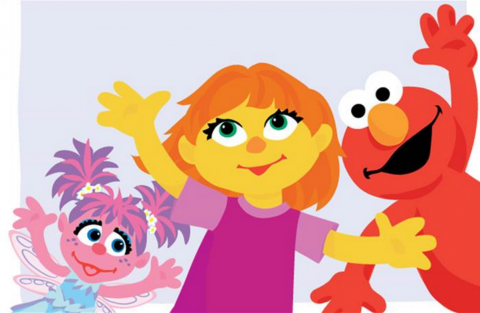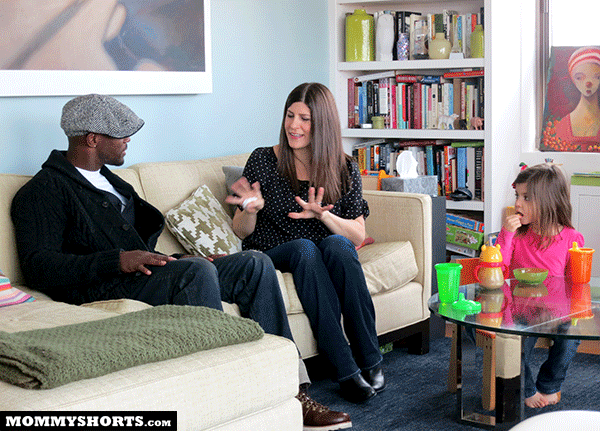
This post was written by my friend Janel Mills, who has three daughters including her daughter Bella who has autism. I felt her reaction to Sesame Street’s newest muppet was way more important than mine.
———————————————–
If you were wondering what all that noise was coming from the Internet this past week (in between Back to the Future Day posts), it was the sound of millions of autism moms and dads cheering.
Sesame Street announced the arrival of Julia, a new Muppet who has autism. The announcement came along with a fabulous online resource center for children and adults to learn more about autism. According to the new website, 1 in 68 children in the U.S. has been diagnosed with autism spectrum disorder, so it’s important to help all children and parents understand these amazing kids.
Kids like mine.
My daughter, Bella, is autistic. She just started kindergarten this year in a mainstream classroom with an aide. One morning, as we stood in line outside waiting for the school day to start, the little girl standing in line in front of my daughter looked up at me. “Are you Bella’s mom?”
“Yes, sweetie, I am!”
“Sometimes Bella is loud. Bella cries a lot,” she said. There was no malice in her voice; it was just a statement. What this little girl was really trying to say was, “I’ve been wondering why Bella acts the way she does, so I’m glad you’re here! You’re an adult who probably knows the answer — tell me why Bella acts like this.” She honestly seemed to just want to know why Bella behaved the way she did. I told her that Bella’s brain works a little differently than most people, and her emotions are so big that sometimes she can’t control them. She listened and nodded, smiled at Bella, and then continued her conversation with another girl about Frozen.
Kids are curious, and they notice EVERYTHING. And with autistic kids, there’s a lot to notice. They are different, but not in a bad way – in an amazing way, as every video and resource on this website points out.
The videos do a great job of pointing out so many of the behaviors and characteristics that typical kids may notice about autistic kids, and explains them clearly, honestly, and with a positive spin.
For example, Thomas has a hard time following the rules about splashing at the aquarium. But instead of focusing on the negative (Thomas broke the rules), Abby Cadabby just chuckles and tells us that Thomas is so excited, he just can’t help himself.
By pointing out behaviors that autistic children exhibit and explaining the emotions behind them, it helps kids recognize behaviors in kids they might know in real life, and help them to be more empathetic towards their friends and classmates.
The best part of introducing this new character is that Sesame Street is bringing autism into the mainstream for kids and parents. So often, parents are afraid to say the “a” word when talking about autistic kids. They don’t quite understand autism beyond what they’ve seen in movies and TV, and don’t want to offend. Since parents don’t understand, they usually don’t talk about it with their children.
Sesame Street, the master of drawing parents and children together to learn, is bringing up a topic that isn’t being discussed in a practical way in the media or pop culture, and making it normal and accessible for them. Most adults know what autism is, but they don’t understand what it means. Sesame Street is giving children the tools to not only understand what it means, but how to interact with kids who have autism they probably know in their own life.
The little girl in my daughter’s morning lineup might have been the first to ask about Bella and her autism, but she won’t be the last. Kids are curious, and Sesame Street knows that where there’s curiosity, there’s room to learn and grow.
Julia and the #SeeAmazing campaign is a bright first step to helping kids and parents, typical and autistic, learn and grow together.
——————————
Read more from Janel at 649.331: Girls, the Care and Maintenance Of.

























I’m happy that Sesame Street is doing this, above all I want other parents to know that autism isn’t a dirty word. The whole vaccine debate has turned autism into this massively feared thing, when those of us who have these amazing children know otherwise. The hard days may nearly break us, but you can’t imagine how amazing it feels when your kid does something you had already come to terms with never seeing.
I was excited to hear this news and look forward to seeing Julia on Sesame Street. It’s a fantastic idea. My kids’ questions about their world seem to get harder to answer everyday, because there’s not always an easy or straightforward answer. As much as it pains me to admit, I don’t have all the answers! 😉 But the resources on Sesame Street at least give me a place to start.
Also, thank you for linking to Janel’s blog; it looks awesome!
Thank you Seasme Street!
My 3 year old nephew has autism and he hates how “none of the Sesame Streets are like him” (His word for muppets)
Jason be exicted to see Julia and relate to her when he watches Sesame Street.
My 4 year old will also begin to understand why Jason “acts funny” sometimes.
Thank you Seasme Street for not having a new “perfect character”